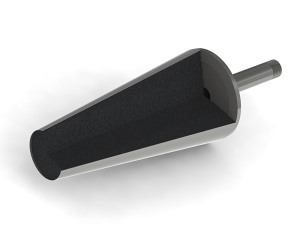What are the main reasons for the damage of ladle breathable bricks?
In the process of using ladle permeable bricks by iron and steel manufacturers, the main reasons for the damage of ladle permeable bricks are thermal stress effect, mechanical wear effect, chemical corrosion effect, and mechanical stress effect.
The ladle breathable brick consists of a breathable core and a breathable seat brick. When the bottom blowing gas is turned on, the working surface of the breathable core will be in direct contact with the high-temperature molten steel. The bottom-blowing gas is a cold airflow, which forms a relatively high temperature difference with the high-temperature molten steel. , With the increase of the number of times of use, due to the rapid cooling and rapid heating, the corrosion of the breathable brick core is deeper, and cracks are easy to occur. This will accelerate the corrosion of the breathable brick. When the upper surface of the breathable brick is higher than the bottom of the bag, it will be sheared and washed by the flow of molten steel. The part above the bottom of the bag will generally be washed away after one use. Yes, after the purification, if the valve is quickly closed, the reverse impact of molten steel will also accelerate the corrosion of the breathable brick. The working surface of the breathable brick core is in contact with steel slag and molten steel for a long time. Steel slag and molten steel contain iron oxide, Ferrous oxide, manganese oxide, magnesium oxide, silicon oxide, etc., while the components of breathable bricks are aluminum oxide, silicon oxide, etc., which will react to form low-melting substances and be washed away.
The working face of the bottom-clad breathable brick is in direct contact with the high-temperature molten steel, and the temperature of the non-working face is relatively low. During the cycle of steel joining, pouring, and hot repairing, the volume of the breathable brick and the adjacent refractory material is caused by the change of temperature. The change of volume, because of the existence of temperature gradient and the different thermal expansion coefficients of the metamorphic layer and the original layer, the degree of volume change in the process from the working face of the breathable brick to the non-working face is abrupt, which will cause shearing of the breathable brick. The shear force will cause cracks in the ventilation bricks in the transverse direction, and in severe cases, the ventilation bricks will be cracked transversely.

Related Industry Knowledge
- Features and Benefits of Coil Clay
- What are the advantages of a good furnace lining
- Misunderstandings in the use of ramming materials in intermediate frequency furnaces
- Phenomenon analysis of failure of argon blowing of ladle permeable bricks and how to improve the rate of argon blowing
- Where is the consumption reduction and energy saving of breathable bricks reflected?
- How to improve the service life of intermediate frequency furnace lining
- Reasons for damage to intermediate frequency furnace lining and how to solve them
- The performance and advantages of breathable brick
- Analysis of Structural Characteristics of Dispersive Breathable Bricks
- The intermediate frequency furnace charge knotting process needs to pay attention to details sharing
- What is the effect of excessive aggregate particles in the lining of the intermediate frequency furnace?
- 5 benefits of using dry ramming mixes
- Precautions for knotting of intermediate frequency furnace lining
- The intermediate frequency furnace ramming material itself is to maintain the furnace and coil
- Ladle breathable brick refractory castable construction method
- How to grasp the selection skills of intermediate frequency furnace charge?
- Describe the characteristics of the ramming material
- Advantages of Coil Clay
- How to improve the temperature resistance of the intermediate frequency furnace lining?
- What are the aspects of reducing energy consumption of breathable bricks?


